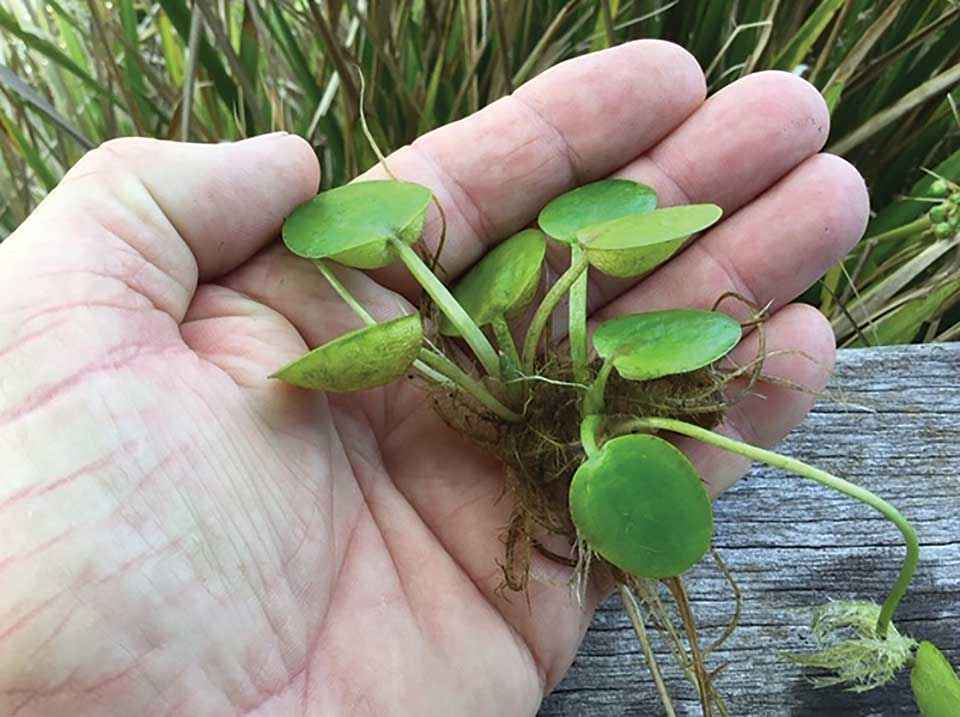Victorian Landcare Magazine - Winter 2021, Issue 81

When faced with an early invader weed at a new location, it’s interesting to consider that every weed has a history.
How did the weed arrive at this location? Was it dumped in garden waste or were the seeds carried by a bird from a nearby garden? What garden did it come from and what is the history of its horticultural origins, popularity, cultivation and use as a garden plant? All weeds must come from somewhere. Every weed has a history.
In 1996, before the internet and mobile phones, faxes were being used to alert Victoria’s chief rangers, flora and fauna and catchment coordinators, about the threat of an invasive orchid. A South Australian botanist and conservationist, Enid Robertson, alerted Victorians that South African weed orchid (Disa bracteata) had spread from Western Australia to South Australia and rapidly established itself in the landscape.

Above: Diminutive and mighty-spreading South African weed orchid (Disa bracteata) in grassy woodland at Beaufort in November 2016. This weed can be difficult to identify contributing to its establishment in Victoria.
Unfortunately, South African weed orchid (SAWO), also called African weed orchid and Monadenia, had already arrived here. The first record was near Bacchus Marsh from 1991 and it was probably in Victoria earlier. The tricky thing with SAWO is that it is small, hard to see and looks like our indigenous ground orchids. Despite its size SAWO releases 2.5 million highly mobile seeds per plant each year.
Fast forward to spring and early summer of 2020. A very wet season and great growing conditions for SAWO. People familiar with SAWO started reporting huge population increases and first-time recorders started finding it in new locations. The distribution map on the Atlas of Living Australia now shows many dots in southern Victoria. It is well and truly established and continuing to expand its range. That’s in just 30 years.
The very fine seeds of SAWO can be blown kilometres by the wind and are easily spread by machinery, vehicles, and on footwear.
In hindsight, it was unrealistic to think it could have been stopped from entering Victoria given the seed-source upwind in South Australia.
Fortunately, there are many environmental weeds that can be prevented from establishing in new areas. Many of them are grown as garden plants. Some recent examples include Amazon frogbit (Limnobium laevigatum), stinking hellebore (Helleborus foetidus), and African or cape daisy (Dimorphotheca or Osteospermum species).

Above: Invasive garden plant African or cape daisy (Dimorphotheca or Osteospermum species) on a roadside in the Wimmera in October 2016. How did it get here?
Amazon frogbit is a floating aquatic plant from South America that is being traded for aquarium and garden use. The first infestation was recorded in Victoria in 2019 at Gembrook and further infestations have been discovered at various sites around Melbourne and in Gippsland. These are under active management to prevent their establishment.
Stinking hellebore is a perennial garden plant from Europe that was recorded recently on a roadside in far south west Victoria within an area of significant native vegetation.
There are several species of African or cape daisy that have been popular with gardeners in recent years and are increasingly being seen in areas of natural vegetation and on random roadsides.
We can influence the future of early invader weeds. DELWP has a statewide project team called Weeds at the Early Stage of Invasion (WESI). The WESI project supports public land and biodiversity managers, including environment-based community groups and volunteers to manage high-risk invasive plants at the early stage of invasion that threaten biodiversity.
The WESI team provide information tools, run training activities on early invader weed identification and share information through social media. You can also subscribe to our online newsletter to help raise awareness and build capability of those dealing with early invader weeds.
Subscribe to newsletter https://www.eventbrite.com.au/e/subscribe-free-to-early-invader-weeds-update-wesi-newsletter-tickets-111894349010
In late 2020, the WESI team collaborated with many agencies and groups, including Landcare Victoria Inc., to develop a series of four webinars about environmental weed management after fire. Each webinar showcases practical examples based on scientific knowledge. The webinars were recorded and remain viewable on-demand.
The webinars were funded by the Victorian Government’s $51.5 million Bushfire Biodiversity Response and Recovery program. For more information go to www.wildlife.vic.gov.au and search for biodiversity, response and recovery.
Weed management after fire webinar recordings https://tinyurl.com/WeedsAfterFire
We may have missed our chance with SAWO in Victoria, however, we can prevent other weeds from becoming established. Landcare group members and landholders are well placed to observe their local environment, observe changes and notice plants that look out of place. Investigating new plant arrivals, recording their location and reporting them early can prevent early invader weeds from getting a foothold. It is essential to seek advice and follow through, including monitoring.
Using the WESI project early invader weed tools and activities can assist with familiarising yourself with new weeds, working out what risk they might pose, how far they have spread and deciding what to do about them. Understanding the history of weeds can reduce their impact on the future.
Manual, tools and newsletter back issues https://www.environment.vic.gov.au/invasive-plants-and-animals/early-invaders
Kate Blood and Bianca Gold are the WESI Team at DELWP funded under the Weeds and Pests on Public Land Program.
For more information go to www.environment.vic.gov.au and search under invasive plants and animals and early invaders, email customer.service@delwp.vic.gov.au or call 136 186.
Socials https://www.facebook.com/groups/earlyinvaderweeds.vic and @weedyk8